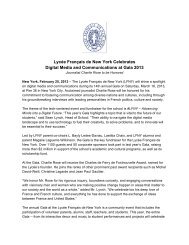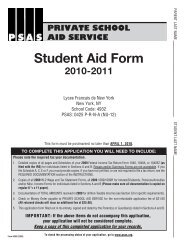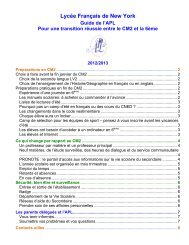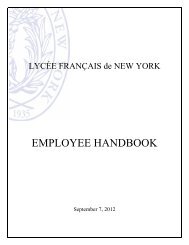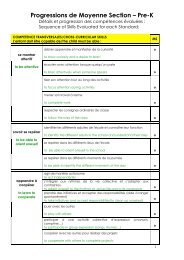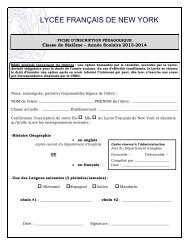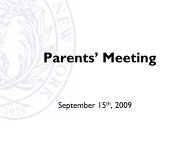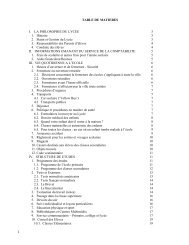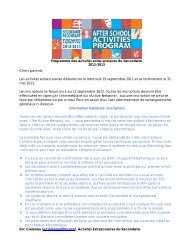E - Lycée Français de New York
E - Lycée Français de New York
E - Lycée Français de New York
You also want an ePaper? Increase the reach of your titles
YUMPU automatically turns print PDFs into web optimized ePapers that Google loves.
MATHGAZINE<br />
M2 ème numéro<br />
Eil 2012<br />
o – avril 20122<br />
numero 2 – Apri<br />
UNE PRODUCTION<br />
DU DEPARTEMENTT DE MATHEMATIQUES<br />
A MATH DEPARTMENT PRODUCTION<br />
EN<br />
ASSOCIATION AVEC / IN ASSOCIATION WITH
MA<br />
ATHGAZINE<br />
MATH AND<br />
YOUTUBE<br />
MATHEMATIQUES ET<br />
YOUTUBE<br />
Maybe you're an<br />
avid user of<br />
Youtube,<br />
the website wheree you can find<br />
all kinds<br />
of vi<strong>de</strong>os, movies, and documentaries.<br />
While enjoying your next stroll through<br />
this site, you could type in the search<br />
Peut-être êtes-vous un fervent utilisateur<br />
du site internet You Tube sur lequel vous<br />
pouvez trouver notamment toute sorte <strong>de</strong><br />
vidéos, films et documentaires. Profitez<br />
<strong>de</strong> votre prochaine balla<strong>de</strong> à travers ce site<br />
bar "histoire <strong>de</strong>s<br />
mathématiques" and pour taper dans la barree <strong>de</strong> recherche<br />
Sommaire p<br />
you'll find a three-part documentary<br />
« histoire <strong>de</strong>s<br />
mathématiques », vouss y - Math and Youtube / 2<br />
(each<br />
lasting about 10 minutes) in trouverez un documentaire<br />
e en trois parties<br />
mathématiques et youtube<br />
French.<br />
(chacune durant environ 100 minutes). - A propos du Jaywalking<br />
3<br />
The<br />
film, created<br />
by the<br />
Ce film<br />
proposé par - About<br />
Jaywalking 4<br />
California<br />
Institute<br />
of<br />
l’institut technologique<br />
- Art & math at the Lycée / 5<br />
Technology and adapted<br />
<strong>de</strong> Californie, et adapté<br />
Art et mathématiques au<br />
in French by the<br />
IUFM<br />
en languee française par Lycée<br />
(teachers<br />
training<br />
l’IUFM (institut <strong>de</strong> - Enseigner et apprendre<br />
6<br />
institute) of Nord-Pas-<strong>de</strong>-<br />
on key<br />
du Nord Pas-<strong>de</strong>-Calais,<br />
Teaching and learning<br />
events<br />
marking<br />
the<br />
se concentre sur certains<br />
with the<br />
NYTimes<br />
formationn <strong>de</strong>s maitres)<br />
avec le NYTimes /<br />
Calais, focuses<br />
beginning of the history<br />
évènements<br />
marquant<br />
- L’histoire du un / The<br />
of mathematics.<br />
<strong>de</strong>s débuts <strong>de</strong> l’histoire<br />
7<br />
story of<br />
one<br />
The<br />
documentary<br />
begins<br />
<strong>de</strong>s mathématiques.<br />
by asking the question<br />
Le documentaire<br />
why mathematics was<br />
invented. We learn that it started in the days<br />
of primitive men when they felt the need to<br />
count. It began to<br />
evolve around 5000 years<br />
ago when the first calendars were created.<br />
This documentary<br />
takes you from Pythagoras<br />
to calculus through the number Pi to square<br />
roots.<br />
It is<br />
a terrific film to un<strong>de</strong>rstand just how<br />
mathematics has evolved over the ages. I<br />
wish you a good journey back in time.<br />
commence par poser la<br />
question <strong>de</strong> savoir pourquoi les mathématiques ont-elles été inventées.<br />
On y apprend notamment que cela a commencé au temps <strong>de</strong> l’homme<br />
primitif, lorsque celui-ci a ressenti le besoin <strong>de</strong> compter, puis tout à<br />
évolué il<br />
y a environ 5000 ans lorsque les hommes ont mis au point les<br />
premiers<br />
calendriers. Ce documentaire vous emmènera notamment <strong>de</strong><br />
Pythagore au calcul infinitésimal en passant par le nombre Pi et les<br />
racines carrées.<br />
C’est sans aucun doute une bonne façon <strong>de</strong> comprendre simplement<br />
comment les mathématiques ont évoluées au cours <strong>de</strong>s âges. Je vous<br />
souhaite donc un bon voyage dans le temps.<br />
Christophe Michot<br />
Christophe Michot<br />
2
A PROPOS DU JAYWA<br />
ALKING …<br />
Dans un numéro du magazine<br />
ZIT <strong>de</strong><br />
l'an <strong>de</strong>rnier, un article bien écrit nous<br />
mettait en gar<strong>de</strong> contre les dangers du<br />
« Jaywalking », l’ acte <strong>de</strong> traverser une<br />
rue illégalement,<br />
que ce soit à un feu<br />
rouge<br />
ou bien en<br />
diagonale. Malgré<br />
toutes les qualités<br />
<strong>de</strong> l'article, je crois<br />
qu'il n'a pas abordé un aspect<br />
crucial<br />
<strong>de</strong> cette situation : pourquoi<br />
traversons-nous la rue <strong>de</strong> manière<br />
illégale <br />
La réponse, bien<br />
sûr, c'est parce que<br />
« Dans tout triangle, la somme <strong>de</strong>s<br />
longueurs <strong>de</strong> <strong>de</strong>ux<br />
côtés est supérieure<br />
à la longueur du troisième côté. » Cela<br />
vous rappelle-t-il quelque chose <br />
C'est<br />
ce que votre professeur <strong>de</strong><br />
math-<br />
-ématiques <strong>de</strong> cinquième appelait<br />
« l'inégalité triangulaire » et<br />
je<br />
suis sûr que vous <strong>de</strong>vez détester<br />
lorsqu’il ou ellee prononce ce<br />
genree <strong>de</strong> trivialités d'une façon<br />
si<br />
obscure. Il y a une raison pour<br />
laquelle nous le faisons, mais<br />
ce<br />
n’est<br />
pas le lieu pour en discuter.<br />
Prenons<br />
plutôt un exemple.<br />
Disons que vous<br />
sortez pour<br />
le<br />
déjeuner et que<br />
vous voulez<br />
manger une pizza. Après avoir<br />
badgé, vous arrivez rapi<strong>de</strong>ment au<br />
coin <strong>de</strong> la 75 ème rue et <strong>de</strong> <strong>York</strong><br />
avenue. Un feu rouge. Pas <strong>de</strong><br />
problème. Vous marchez tout<br />
droit le long <strong>de</strong><br />
<strong>York</strong> avenue<br />
jusqu'à la 76ème rue.<br />
C’est là que les choses<br />
se<br />
compliquent. Vous êtes au coin<br />
sud <strong>de</strong><br />
la 76<br />
ème rue et <strong>de</strong> <strong>York</strong> avenue,<br />
et bien<br />
sûr, le feu est toujours rouge pour<br />
traverser <strong>York</strong> avenue. Curieusement,<br />
il est<br />
également rouge pour traverser<br />
la 76<br />
ème rue. C'est quelque chose que<br />
je n’ai vu qu’à <strong>New</strong> <strong>York</strong>, rouge dans<br />
les <strong>de</strong>ux sens pour les piétons. Quoi<br />
qu'il en soit, soyez honnête, je<br />
sais et<br />
vous savez que vous allez tout <strong>de</strong><br />
même traverser la<br />
76 ème rue au<br />
rouge,<br />
d'abord parce que c'est une rue et qu’il<br />
ne vous faudra pas si longtemps pour<br />
le faire, et ensuitee parce que c'est une<br />
rue à sens unique<br />
et que vous<br />
pensez<br />
que vous pouvez<br />
facilement voir si<br />
<strong>de</strong>s voitures arrivent. Et voilà un<br />
premier Jaywalking !<br />
Maintenant, vous<br />
êtes sur le côté<br />
nord <strong>de</strong> la 76 ème<br />
rue (utilisez z une carte<br />
si vous avez du mal à suivre) ). Voici ce<br />
que<br />
vous êtes supposé faire: attendre<br />
le feu vert, traverser les 13 mètres <strong>de</strong><br />
<strong>York</strong> avenue, tourner d’un angle <strong>de</strong><br />
quatre-vingt-dix<br />
<strong>de</strong>grés verss la droite<br />
et marcher les quelques 55 mètres qui<br />
vous séparent <strong>de</strong> Batman City. (Oui,<br />
c'est une étu<strong>de</strong> <strong>de</strong> terrain, vous auriez<br />
pu me voir mesurant les longueurs.)<br />
Mais non, vous préférez faire ce<br />
chemin en diagonale parce que, selon<br />
« l'inégalité triangulaire », c’est le<br />
plus court chemin. Mais plus court à<br />
quel point Eh bien, le bon vieux<br />
Pythagore vous<br />
dit que la diagonale<br />
est<br />
légèrement inférieure à 577 mètres.<br />
Ainsi, au lieu <strong>de</strong> 68 mètress (55+13)<br />
vous en êtes<br />
à 57, soit une<br />
amélioration <strong>de</strong> 11 mètres. Disons que<br />
vous marchez à un rythme tranquille<br />
<strong>de</strong> 1,5 mètre par secon<strong>de</strong>. Cela<br />
signifie que vous avez gagné à peine<br />
plus <strong>de</strong> 7 secon<strong>de</strong>s sur unn parcours<br />
d’environ 45 secon<strong>de</strong>s.<br />
Cela en vaut-il<br />
la peine Eh bien, il<br />
faut prendre en<br />
compte lee fait que<br />
pendant les 38<br />
secon<strong>de</strong>s <strong>de</strong> votre<br />
périple, vous avez été exposé au<br />
trafic. Et vous savez quoi En 38<br />
secon<strong>de</strong>s, une voiture passant à 48<br />
kilomètres par heure (la vitesse limite<br />
en ville) parcourt près <strong>de</strong> 0.507<br />
kilomètres soit 507 mètres, ou encore<br />
la longueur <strong>de</strong> cinq terrains <strong>de</strong><br />
football.<br />
Pensez-vous<br />
que<br />
vous<br />
pouvez voir aussi loin Et pensez-<br />
vous que toutes ces<br />
voitures<br />
respectent la limite <strong>de</strong> 48 km/h À 80<br />
km/h une voiture parcourt 8 terrains<br />
<strong>de</strong> football en<br />
30 secon<strong>de</strong>s.<br />
Très bien. Maintenant, je<br />
vois venir<br />
vos objections. D'abord la<br />
différence<br />
<strong>de</strong> temps <strong>de</strong> 7 secon<strong>de</strong>s est incorrecte<br />
parce que je n'ai pas compté le temps<br />
d'attente pour<br />
que le feu passe au vert.<br />
Certes, ces feux rouges peuvent être<br />
long, mais en<br />
moyenne, vous <strong>de</strong>vriez<br />
compter sur une attente d’environ 45<br />
secon<strong>de</strong>s,<br />
voire moins<br />
si l'on<br />
considère que le feu était déjà au<br />
rouge sur la 75 ème rue et que vous avez<br />
marché jusqu'à <strong>York</strong> avenue pendant<br />
quelques secon<strong>de</strong>s au cours <strong>de</strong>squelles<br />
le feu rouge s’est rapproché du<br />
vert. Bien<br />
entendu, si le feu avait<br />
été vert à la 75 ème rue, vous auriez<br />
franchi <strong>York</strong> avenue tout <strong>de</strong> suite.<br />
Fin <strong>de</strong> la<br />
discussion. Deuxième<br />
objection.<br />
Vous pensez : « Eh<br />
bien, je ne<br />
suis pas stupi<strong>de</strong>. Je sais<br />
que je suis en danger en traversant<br />
la rue au<br />
feu rouge, donc je ne<br />
marche pas, en fait je cours ou au<br />
moins trottine. » D’accord, soyons<br />
raisonnables et supposons que<br />
vous pouvez accélérer r jusqu'à une<br />
vitesse <strong>de</strong><br />
3 mètres par secon<strong>de</strong>,<br />
réduisant ainsi votre<br />
temps <strong>de</strong><br />
passage <strong>de</strong> moitié. Refaisons les<br />
calculs : environ 19 secon<strong>de</strong>s pour<br />
traverser en diagonale contre 88<br />
secon<strong>de</strong>s (45 secon<strong>de</strong>s pour le temps<br />
d'attente, ainsi que 43 secon<strong>de</strong>s <strong>de</strong><br />
marche). Oui,<br />
vous avez en fait gagné<br />
plus d'une minute.<br />
Donc imaginez un peu ! Afin<br />
d'économiser une minute<br />
sur votre<br />
pause déjeuner (et nonn pas <strong>de</strong>ux<br />
minutes, parce que tout le<br />
mon<strong>de</strong> sait<br />
bien que vous<br />
n'êtes pas dans une telle<br />
hâte pour revenir au lycée), vous êtes<br />
prêt à passer<br />
17 secon<strong>de</strong>s au milieu<br />
d’une avenuee remplie <strong>de</strong> bus, <strong>de</strong> taxis<br />
et <strong>de</strong> vélos. Ne soyez pas ridicule!<br />
Dites non au Jaywalking!<br />
David Soquet<br />
3
ABOUT JAYWALKING<br />
In one issue of last year’s ZIT, a well written article was<br />
warning against the dangers of jaywalking, the act of<br />
crossing a street in a wrong way, either on<br />
a red light or<br />
diagonally. Despite all the qualities of the article, I believe<br />
it failed to address one crucial aspect of the<br />
situation: why<br />
do we jaywalk<br />
The<br />
answer, of course, is because “In any triangle, the<br />
sum of the lengths of any two si<strong>de</strong>s is greater than the<br />
length of the third.” Ring a bell Well, that’s what your<br />
7th gra<strong>de</strong> teacher calls “L’inégalité triangulaire” and<br />
I<br />
know<br />
you must hate it when<br />
your math teacher utters<br />
trivialities in such<br />
an arcane way. There is<br />
a reason why<br />
we do it, but let’s<br />
not get into that here. Better to take an<br />
example. Let’s say<br />
you come out for lunch and want to get<br />
a pizza. After badging out, you<br />
quickly reach the corner of<br />
75th Street and <strong>York</strong>. A red light. No problem there. You<br />
walk<br />
straight along <strong>York</strong> until you reach 76th Street.<br />
Let’s sayy you walk att a leisurely pace of 5 feet<br />
per second.<br />
That means you gained 7 seconds on a 41-second walk.<br />
Is it worth it Well, , you have to<br />
consi<strong>de</strong>r that during the<br />
34 seconds of your crossing, you were exposed to<br />
oncoming traffic. And you know<br />
what In 34<br />
seconds, a<br />
car going at 30 miless per hour (the speed limit<br />
in the city)<br />
travels more than 0.283 miles or 1496 feet. That’s about<br />
500 yards, which is the length of<br />
five football fields. Do<br />
you think you can see that far And do you think all those<br />
cars respect the 30 mph limit At 50 mph the car covers 8<br />
football fields in half f a minute.<br />
Okay. Now I see your objections coming. First, the time<br />
difference of 7 seconds is wrong because I didn’t count the<br />
waiting time for the light to go green. Granted, those red<br />
lights can be long. But, on average, you should expect to<br />
wait about 45 seconds, even less if you consi<strong>de</strong>r that the<br />
light wass already red on 75th Street and you walked up<br />
Now<br />
comes the<br />
tricky part.<br />
You are at<br />
the southeast<br />
corner of 76th and <strong>York</strong> and, of course, it is still red to<br />
crosss <strong>York</strong>. Oddly, it is also red to cross over 76th. That’s<br />
something I’ve seen only in <strong>New</strong> <strong>York</strong>, red<br />
both ways for<br />
pe<strong>de</strong>strians. Anyway, be honest, I know and you know<br />
that you will cross 76th streett on red, first<br />
because it’s<br />
a<br />
streett and it doesn’t take that long, and second because it’s<br />
a one-way street, and you think you can easily check for<br />
oncoming cars. That’s your first jaywalk right there.<br />
Now<br />
you should<br />
be on the north si<strong>de</strong> of 76th Street (use<br />
a<br />
map if you find it<br />
hard to follow). Here is what you ought<br />
to do: wait for the green light, cross the 40 feet of <strong>York</strong><br />
Avenue, take a sharp ninety-<strong>de</strong>gree turn to<br />
the right and<br />
walk<br />
164 feet to Batman City. (Yes, this is a field study.<br />
You could have seen me pacing<br />
the distances.)<br />
But, no, you prefer to do it diagonally because according<br />
to “l’inégalité triangulaire”, it is the shortestt path. But how<br />
short<br />
is that Well, good old Pythagoras tells you that the<br />
diagonal is a bit less than 169 feet. So instead of 204 feet<br />
(164+ +40), you’re down to 169, an improvement of 35 feet.<br />
<strong>York</strong> forr a few seconds during which, the red light moved<br />
closer too green. Of course, if the<br />
light had been green at<br />
75th Street you would have crossed <strong>York</strong> right away. End<br />
of discussion.<br />
Secondd objection. You’re thinking: ”Well, I’m<br />
not stupid.<br />
I know I’m in danger on the street with a red light so I<br />
don’t jaywalk. I actually jayrun or<br />
at least jaytrot.” Alright,<br />
let’s be reasonable and assume you can speed up to 10 feet<br />
per second, thus reducing your crossing time by<br />
half. Let’s<br />
add it up: about 17 seconds to cross diagonally<br />
against 86<br />
seconds (45 seconds waiting time plus 41 seconds<br />
walking) ). Yes, you actually saved more than a minute.<br />
So there you are! In or<strong>de</strong>r to save one minute of your<br />
lunch period (and not two minutes becausee everybody<br />
knows you’re not in such a hurry<br />
on your way<br />
back from<br />
lunch), you’re ready<br />
to spend 17<br />
seconds on<br />
an avenue<br />
filled with buses, taxis and bikes. Don’t be ridiculous! Be<br />
smart. Don’t jaywalk<br />
!<br />
David Soquet<br />
4
ART AND MATH AT THE LYCEE<br />
In 7th gra<strong>de</strong> math class, stu<strong>de</strong>nts learn about point<br />
symmetry, that is symmetry with respect to a central point<br />
in a figure. For several years, 7 th gra<strong>de</strong> stu<strong>de</strong>nts have been<br />
working on a six-week project that culminates in a <strong>de</strong>tailed<br />
and colorful tessellation. This project reflects work done in<br />
parallel with the art <strong>de</strong>partment which, in 7 th gra<strong>de</strong>, studies<br />
broa<strong>de</strong>r tessellations.<br />
Tessellations in<br />
math are<br />
slightly different than<br />
tessellations in art. In math, each drawing must satisfy the<br />
<strong>de</strong>mands of point symmetry, that is to have a central<br />
reflection point. The colors<br />
must also<br />
respect this<br />
symmetry! Tessellations in art, rather, are images that<br />
repeat themselves over and over again.<br />
The drawings produced in 5e1 inclu<strong>de</strong> snowmen, frogs,<br />
imaginary animals and geometric figures. They reflect the<br />
different talents and the extraordinary imagination of our<br />
stu<strong>de</strong>nts.<br />
Vivianne Kurzweil<br />
Images<br />
of this issue of Mathgazine are productions of 5 e 1 stu<strong>de</strong>nts.<br />
ART ET MATHEMATIQUES AU<br />
LYCEE<br />
En mathématiques,<br />
les élèves <strong>de</strong> cinquième apprennent la<br />
symétriee centrale, c’est-à-dire la symétrie par rapport à un<br />
point. Depuis plusieurs années,<br />
certains élèves <strong>de</strong> 5 e<br />
travaillent sur un projet <strong>de</strong> 6 semaines qui culmine par la<br />
réalisation d’un pavage détaillé et multicolore. Ce projet<br />
reflète un travail effectué <strong>de</strong> façon parallèle avec le<br />
département d’art qui, en 5 ème , fait<br />
étudier les tessellations.<br />
Les pavages en maths sont légèrement différents <strong>de</strong>s<br />
tessellations en art. Chaque pavage effectué doit satisfaire<br />
les <strong>de</strong>man<strong>de</strong>s <strong>de</strong> la symétrie centrale, c’est-à-dire avoir un<br />
centre <strong>de</strong> symétrie<br />
(au milieu <strong>de</strong> l’image).<br />
Les<br />
couleurss doivent elles aussi respecter cette symétrie! Les<br />
tessellations satisfontt plutôt à la <strong>de</strong>man<strong>de</strong> <strong>de</strong> reproduction<br />
d’une même image sur une certaine surface.<br />
Les pavages en 5 e 1 comprennent <strong>de</strong>s fuseaux, <strong>de</strong>s<br />
bonhommes <strong>de</strong> neige, <strong>de</strong>s grenouilles, <strong>de</strong>s animaux<br />
imaginaires et <strong>de</strong>s figures géométriques. Elles reflètent les<br />
différents talents et l’imagination extraordinaire <strong>de</strong> nos<br />
élèves.<br />
Vivianne Kurzweil<br />
Les images <strong>de</strong> ce numéro <strong>de</strong> Mathgazine sont les productions <strong>de</strong>s<br />
élèves <strong>de</strong> 5 ème 1.<br />
5
ENSEIGNER ET APPRENDRE<br />
AVEC LE NEW<br />
YORK TIMES<br />
Très régulièrement, le <strong>New</strong> <strong>York</strong> Times vous propose un<br />
Math<br />
Quiz portant sur <strong>de</strong>s sujets très divers : une façon<br />
pour les parents <strong>de</strong> proposer à leurs enfants un autre type<br />
<strong>de</strong><br />
support<br />
pédagogique<br />
faisant le lien entre les<br />
mathématiques, l’actualité ainsi que l’apprentissage<br />
<strong>de</strong><br />
l’anglais. La plupart <strong>de</strong>s questions à choix<br />
multiples sont<br />
proposées par l’association MFA, Math For America, une<br />
association <strong>New</strong> <strong>York</strong>aise dont l’objectif principal est <strong>de</strong><br />
promouvoir<br />
et <strong>de</strong> valoriser<br />
l’enseignement<br />
<strong>de</strong>s<br />
mathématiques aux Etats-Unis.<br />
Les thèmes concernent aussi bien les sports, l’éducation,<br />
les sciences, les<br />
affaires sociales, l’art ou encore la<br />
mé<strong>de</strong>cine. Vous verrez que beaucoup <strong>de</strong><br />
questions font<br />
appel<br />
à <strong>de</strong>s opérations mathématiques élémentaires, celles-<br />
<strong>de</strong><br />
ci étant mise en place par chacun après un<br />
petit travail<br />
lecture et <strong>de</strong> décryptage <strong>de</strong> texte. Aussi, chaque<br />
questionnaire est établi à partir d’un article<br />
mentionné par<br />
The <strong>New</strong> <strong>York</strong> Times, ce qui permettra à chacun d’élargir<br />
ses connaissances.<br />
Vous pouvez retrouver chaque semainee <strong>de</strong> nouvelles<br />
questions<br />
à<br />
l’adresse<br />
suivante<br />
:<br />
http:/ //learning.blogs.nytimes.com/tag/tymath/<br />
Have<br />
fun !<br />
Fatiha Messaoudi De Saint Sernin<br />
TEACHING AND<br />
LEARNING WITH THE NEW YORK TIMES<br />
Very often, The<br />
<strong>New</strong> <strong>York</strong> Times offers a math quiz on<br />
diverse topics as a way for parents to offer their children<br />
different kinds of<br />
teaching materials linking mathematics,<br />
current events and<br />
also the learning of English. Most of the<br />
questions are suggested by the<br />
association MFA (Math For<br />
America), a <strong>New</strong> <strong>York</strong> association whose main objectivee is<br />
to promote and enhance the teaching of mathematics in the<br />
United States.<br />
The<br />
topics are as diverse as<br />
sports, education, science,<br />
social affairs, art<br />
and medicine. You willl see that many<br />
questions involve<br />
basic mathematical calculations, after a<br />
reading and un<strong>de</strong>rstanding of a short text. Also, each<br />
question is drawn<br />
from a recent article in<br />
The <strong>New</strong> <strong>York</strong><br />
Times, allowing everyone to broa<strong>de</strong>n their knowledge.<br />
You can find new problems every week at the following<br />
address: http://learning.blogs.nytimes.com/tag/tymath/<br />
Have<br />
fun !<br />
Fatiha Messaoudi De Saint Sernin<br />
<strong>New</strong> <strong>York</strong> Times du 22 février 2012:<br />
Test your math skills with this question created by David<br />
Prince at Math for America from the article “After<br />
Giants’ ’ Surreal Touchdown, Debates on the Strategy.”<br />
After Super Bowl XLVI last Sunday, Bill Belichick was<br />
quoted as saying there is a 90% field goal conversion rate<br />
from within the ten yard line.<br />
Assuming Bill Belichick’s estimate is correct, if the<br />
Giants tried three field goals from<br />
within the ten yard line,<br />
what is the probability they would<br />
hit exactly two<br />
A. 72.9% B. 8.1%<br />
C. 24.3%<br />
D. 48.6% E. 2.7%<br />
<strong>New</strong> <strong>York</strong> Times du 07 mars 2012:<br />
Test your math skillss with this question created by Bobson<br />
Wong at Math for r America from the article “Is This<br />
Living Room Big Enough for My TV”<br />
As the article notes, , experts recommend that the viewer’s<br />
i<strong>de</strong>al distance from a TV screen<br />
should be 1.5 times the<br />
diagonal screen measurement. If a person has a TV with a<br />
screen that measures 29.4 inches high and 52.3 inches<br />
wi<strong>de</strong>, about how many feet should the person<br />
be from the<br />
screen to watch comfortably<br />
A. 60 B. 7.5 C. 10 D. 13 E. 5<br />
NBB : articles issus du <strong>New</strong> <strong>York</strong> Times laissés en version anglaise<br />
<strong>New</strong> <strong>York</strong> Times du 22 février 2012:<br />
Test your math skills with this question created by David<br />
Prince at Math for America from the article “After<br />
Giants’ ’ Surreal Touchdown, Debates on the Strategy.”<br />
After Super Bowl XLVI last Sunday, Bill Belichick was<br />
quoted as saying there is a 90% field goal conversion rate<br />
from within the ten yard line.<br />
Assuming Bill Belichick’s estimate is correct, if the<br />
Giants tried three field goals from<br />
within the ten yard line,<br />
what is the probability they would<br />
hit exactly two<br />
A. 72.9% B. 8.1%<br />
C. 24.3%<br />
D. 48.6% E. 2.7%<br />
<strong>New</strong> <strong>York</strong> Times du 07 mars 2012:<br />
Test your math skillss with this question created by Bobson<br />
Wong at Math for r America from the article “Is This<br />
Living Room Big Enough for My TV”<br />
As the article notes, , experts recommend that the viewer’s<br />
i<strong>de</strong>al distance from a TV screen<br />
should be 1.5 times the<br />
diagonal screen measurement. If a person has a TV with a<br />
screen that measures 29.4 inches high and 52.3 inches<br />
wi<strong>de</strong>, about how many feet should the person<br />
be from the<br />
screen to watch comfortably<br />
A. 60 B. 7.5 C. 10 D. 13 E. 5<br />
6
L’HISTOIRE DU UN<br />
Peut-être êtes-vous un fervent utilisateur <strong>de</strong>s sites <strong>de</strong><br />
vidéos en ligne comme Netflix. Profitez <strong>de</strong> votre prochaine<br />
balla<strong>de</strong> pour regar<strong>de</strong>r directement en ligne<br />
« the story of<br />
1 », le documentaire <strong>de</strong> la BBC réalisé en 2005 par Terry<br />
Jones, ex membre <strong>de</strong>s Monty Python. Ce film <strong>de</strong> 59<br />
minutes, dans lequel on retrouve l’humour<br />
et la folie <strong>de</strong>s<br />
créateurs du Sacré<br />
Graal, du Sens <strong>de</strong> la Vie et bien d’autres<br />
films, retrace la naissance du chiffre 1. Sans vouloir tout<br />
raconter, vous voyagerez au travers <strong>de</strong> civilisations et <strong>de</strong><br />
pays aussi différents que la Mésopotamie,<br />
l’Egypte et la<br />
Grèce antique, l’In<strong>de</strong>, … passant <strong>de</strong> l’os d’Ishango<br />
découvert récemment au Congo a la construction<br />
du<br />
premier ordinateur Colossus durant la secon<strong>de</strong> guerre<br />
mondiale basé sur <strong>de</strong>s travaux<br />
effectués par Leibniz à la<br />
fin du<br />
dix-septième siècle.<br />
Dans ce documentaire on y trouve notamment un passage<br />
intéressant sur Pythagore et non pas son théorème mais sur<br />
son travail fait liant les nombres et les harmonies<br />
musicales. On y découvre aussi, et c’est<br />
la théorie <strong>de</strong><br />
l’auteur Terry Jones, les raison<br />
pour lesquelles le système<br />
<strong>de</strong> numération romain est vite tombé en désuétu<strong>de</strong>.<br />
Enfin le 1 ne serait pas grand-chose sans son alter ego, le<br />
0. C’ ’est en In<strong>de</strong> que … je n’en dirais pas plus, et je vous<br />
invite<br />
fortement à regar<strong>de</strong>r ce film.<br />
Christophe Michot<br />
THE STORY OF ONE<br />
Maybee you are an avid user of online vi<strong>de</strong>o sites such as<br />
Netflix. On your next visit to the site, be sure to watch<br />
"The Story of One", the BBC documentary ma<strong>de</strong> in 2005<br />
by Terryy Jones, former member of Monty Python. In the<br />
59-minute film, which traces the<br />
birth and emergence of<br />
the number “1”, we find the humor and madness of the<br />
creators of the Holy Grail, the Meaning of Life, and many<br />
other films. You willl travel through cultures and countries<br />
as diverse as Mesopotamia, Egypt, ancient Greece, and<br />
India--from the bone<br />
of Ishango recently discovered in the<br />
Congo to the construction of Colossus, the first computer<br />
created during the Second World<br />
War and based on work<br />
by Leibniz at the end<br />
of the Seventeenth century.<br />
In the documentary, we find a particularly<br />
interesting<br />
piece onn Pythagoras, , not on his theorem, but on his work<br />
linking numbers and<br />
musical harmonies. Terry<br />
Jones also<br />
offers his own theory<br />
on why the<br />
Roman numeral system<br />
fell into disuse.<br />
Finally, “1” would<br />
not be much without its alter ego,<br />
“0”. It was in India ... I will say no more, and<br />
urge you to<br />
watch this film.<br />
Christophe Michot<br />
7



